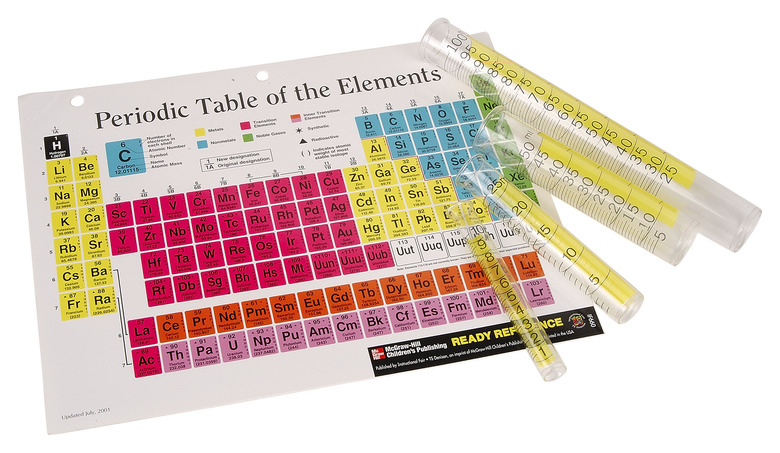How To Count Particles In Chemical Formulas
A chemical formula indicates chemical compounds composed of elements expressed by alphabetical symbols on the Periodic Table of Elements. Each symbol identifies the type of atomic element present in the compound and in what ratio. A subscript number in the chemical compound indicates the amount of atoms of a specific element found in a molecule. Subatomic particles are protons, neutrons and electrons that form an atom. Atomic weight measures the total number of particles in an atom's nucleus. Let's look at the example of calcium hydroxide Ca(OH)2.
Count Atoms in the Chemical Compound
Step 1
Recognize the individual elements in the formula, Ca(OH)2. This gives you three different elements in the chemical compound: Calcium Ca, Oxygen O, and Hydrogen H.
Step 2
Determine the number of atoms of an element in Ca(OH)2. To find this, look for the subscript number written after the element symbol Ca(OH)2. If a subscript is absent then there is only one atom. Since Ca has no subscript number, Ca has one atom.
Step 3
Determine the number of a polyatomic ion. Polyatomic ions are easily recognized in the formula when there are more than two elements in the formula. In Ca(OH)2, the subscript number "2" after the parentheses indicates two OH polyatomic ions, giving you two Os atoms and two Hs. Using mathematical method, take the subscript of the element inside the parenthesis and multiply it by the subscript for the entire polyatomic ion outside the parenthesis. In our example, the absence of subscripts for the O and H shows that there is one atom of each. Thus, multiply 1 by 2 for two atoms of O and 1 by 2 for two atoms of H.
Write down the result: Ca – 1 atom; O – 2 atoms; H – 2 atoms.
Counting Particles in Atoms
Step 1
Find the atomic number and atomic weight of each element from The Periodic Table of Elements. Ca has atomic weight 40.078 and atomic number 20. The number of protons will be your atomic number, which is 20. This tells you that Ca has 20 protons in its nucleus. The atom must have equal numbers of protons and electrons to sustain balance; therefore, Ca contains 20 electrons.
Step 2
To find the number of neutrons, round up the atomic weight of Ca to the nearest whole number. Ca atomic weight is 40.078. Forty is the mass number.
Use the formula: Mass Number = (number of protons) + (number of neutrons).
Arrange the formula to find numbers of neutrons:
Number of neutrons = (mass number) – (number of proton).
Number of neutrons = 40 – 20 = 20. Ca has 20 neutrons.
Step 3
Apply the same method for oxygen O and H. O has 8 protons, 8 electrons, and 16 – 8 = 8 neutrons. H has 1 proton, 1 electron and no neutrons.
Step 4
The chemical formula Ca(OH)2 has 20 protons, 20 electrons and 20 neutrons of Ca. Two ions of OH will give you 16 protons, 16 electrons, 16 neutrons of oxygen O, and 2 proton 2 electron of hydrogen H.
Adding all the particles in Ca(OH)2 gives you: 20 + 16 + 2 = 29 protons; 20 + 16 + 2 = 37 electrons; 20 + 16 + 0 = 36 neutrons.
Things Needed
- Periodic Table of Elements
- Pen/Pencil
- Paper
- Calculator
References
Cite This Article
MLA
Kambak, J.R.. "How To Count Particles In Chemical Formulas" sciencing.com, https://www.sciencing.com/count-particles-chemical-formulas-5799046/. 24 April 2017.
APA
Kambak, J.R.. (2017, April 24). How To Count Particles In Chemical Formulas. sciencing.com. Retrieved from https://www.sciencing.com/count-particles-chemical-formulas-5799046/
Chicago
Kambak, J.R.. How To Count Particles In Chemical Formulas last modified August 30, 2022. https://www.sciencing.com/count-particles-chemical-formulas-5799046/
